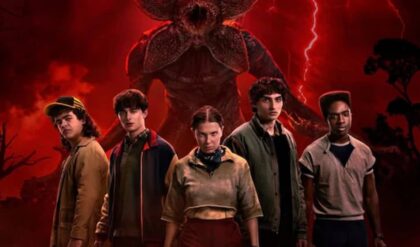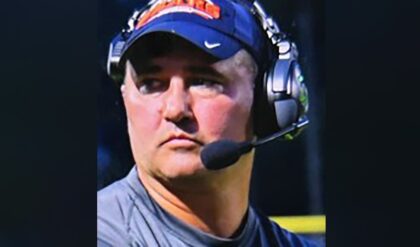Behind the scenes with ‘True Detective’s most gruesome prop yet.
The second episode of True Detective: Night Country introduces what might just be the greatest word in the English language: corpsicle.
That’s what Ennis police chief Liz Danvers (Jodie Foster) calls the corpses of scientists who went missing from the Tsalal Arctic Research Station. They’re frozen together, naked, in a twisted mass of snow and flesh. Frostbite has ravaged their skin, pools of blood are frozen mid-ooze from their ears, and fear has twisted their faces into uncanny death masks.
As Liz and her team move the corpsicle from the Alaskan wilderness to a local ice rink for thawing, Night Country’s creator and director Issa López makes sure we don’t miss a single grisly detail. The camera lingers on each corpse, catching every frost-covered hair and blackened finger in harsh, bright light. Creating such an involved series of prosthetics would be challenging enough, but having them hold up under such intense scrutiny adds a greater layer of difficulty, one that renders the final product even more astonishing.
To learn more about the creation of Night Country‘s spectacular corpsicle, Mashable spoke with production designer Daniel Taylor (Tetris, Argylle) and prosthetics team Dave and Lou Elsey (Star Wars: Episode III — Revenge of the Sith, Beauty and the Beast), a married team who oversee the SFX and prosthetics studio Igor Studios. Over our separate video calls, Taylor and the Elseys revealed which artists and films inspired the corpsicle, the painstaking level of detail that went into making each corpse, and how they depended on the Icelandic elements while shooting on location for some finishing touches. The massive prop you see on screen is a marvel, but this oral history proves that the process behind the corpsicle is just as impressive as the end result.
The following conversations have been condensed and edited for clarity.
How do you even begin to approach a “corpsicle”?
 Finn Bennett and Jodie Foster in “True Detective: Night Country.”Credit: HBO
Finn Bennett and Jodie Foster in “True Detective: Night Country.”Credit: HBO
Daniel Taylor, production designer: My initial reaction to the bodies in episode 1 was, “Oh God, we’ve got to go up a mountain and dig a couple of bodies into the snow. I hope we do that on a soundstage so it’s not cold.” Then, when you get to episode 2, and you actually understand the full horror — immediately you’re like, “What is this going to look like? How is this tangle going to be? Is one head going to be facing down and one head going to be up? Are they going to have all their arms locked in a line? How does this work?”
Dave Elsey, prosthetics: A lot of things we get asked to do, we’ve never done before. People come up to us, and they say, “Can you make an alien for a movie?” And we’re like, “Sure, we’re not 100 percent [sure how], but we kind of know how to do it.” But this one was such a great thing. The very first word they used was “corpsicle.” And we were like, “We totally get it.”
Lou Elsey, prosthetics: Immediately. “Okay, we’re in!”
The very first word they used was “corpsicle.” And we were like, “We totally get it.”
Dave Elsey
DT: Then you need to start thinking about this prosthetic, because this is an incredibly complicated build. It’s a huge amount of money, and it’s such an important part of the story.
Ordinarily, on a police drama where there’s a dead body in the background, it’s referred to or talked over. And then it’s pushed back into its refrigerator unit and it’s forgotten. Here, we see the corpsicle in the ice rink in the full, bright light. We see it in a mound on the mountain, and we obviously see it thawing in various stages. So I think for something like True Detective, where you need to do these effects in-camera, it’s an incredibly important part to get right.
DE: We could instantly tell that it was not just going to be one of those jobs where you’re making a bunch of dead bodies and you throw them into position and it’s gonna be fine. It was going to be something a lot more than that.
LE: What was really nice about it is that it wasn’t just dead bodies and corpses. It was almost like making a Baroque painting. It was like an art piece, and it was telling the story.
DE: It’s a frozen moment in time.
Freezing time: Artistic influences and positioning the bodies
 Kali Reis, Jodie Foster, and Finn Bennett in “True Detective: Night Country.”Credit: HBO
Kali Reis, Jodie Foster, and Finn Bennett in “True Detective: Night Country.”Credit: HBO
One of the biggest questions for production designer Daniel Taylor and showrunner Issa López was how they prepared to bring the concept of a corpsicle to life. For this, they turned to films like Ringu (Ring) and artists like Berlinde de Bruyckere, Phil Hale, and Francis Bacon for inspiration.
DT: Issa’s obviously got a Pinterest board with references she really likes. If you’ve seen the Japanese Ring, there’s a moment when we find a body in a cupboard. There’s a dislocated jaw, and the eyes are looking off at an angle, and Issa was very moved by that.
There’s also a Belgian sculptor named Berlinde de Bruyckere who’s very well known for doing these visceral sections of human and animal form, building it up with layers of fabric and silicone. Things have been stretched and dislocated and removed. We wanted that to feed into our corpsicle build. Then there’s an American painter called Phil Hale. And he’d painted a skull, like a shrunken head where the skin has started to dry and pull away from the mouth, and the mouth has been dislocated and [the] eyes are looking really wide at something horrific. Now, that was a real point of reference for her. And then there’s Francis Bacon — he had moments from his work that fit into the corpsicle as well.
In building the corpsicle, Dave and Lou Elsey also drew inspiration from movies, as well as from Baroque paintings and Christy Lee Rogers’s Baroque-style photographs when it came to creating a sense of movement.
DE: After we read the script, right away we could tell that there were little hints of Se7en in there. The other big reference for us was The Silence of the Lambs. The scene I always remember was the autopsy of the girl where they find the moth in her mouth. Just the atmosphere of that, trying to make something that had some of that atmosphere. It was horrific, ugly, and beautiful at the same time.
DT: Dave and Lou did some of their own concept work too. There’s a photographer, Christy Lee Rogers, that took photos under the water of dancers in Baroque classical outfits or costumes, and the way their clothing moves underwater almost felt like they’d been frozen in time. The idea was that the corpsicle guys were very much just paused at that point of death.
LE: It was really about just capturing that moment and feeling the emotional connections between the characters.
Positioning-wise, Taylor, the Elseys, and López conceived of a structure like a “cheese wedge.”
DT: Issa wanted the very first body to be basically flat on his back. The corpsicle gets higher the further away we get from the first one, and obviously, as they’re being dug out of the snow, more and more is revealed because you see the highest one first. So they almost form, like, a cheese wedge.
DE: The very first body in that wedge is in a fetal position. It’s one of the saddest. Then gradually, they’re more and more twisted, and there are little scenes that they have together. Some of them are interacting. Some of them are looking at each other. Some of them have torn their eyes out. Things like that.
LE: We had these little posable artists’ dolls that move very much like a human body. We put them all together in all these different positions, and we discussed it with Issa and Daniel and worked out the story we were trying to tell, because we wanted to have each character be connected in some way. Issa wanted to create little stories within their positioning. Once we worked that out, we then moved into a 3D model that you see in 360 degrees, and we could look and see where they would fit within the ice.
DE: Ordinarily, we would have done full body casts, but the positions were so specific, the actors just wouldn’t have been able to hold the pose for as long as it took to do a body cast. We met all the actors on the very first day, and we got them to strip to their underpants and we scanned their bodies. The great thing about that is that you can get them to take these very, very extreme positions that they need to be in, and then you can do a snapshot of it from 360 degrees. And you’ve suddenly got a digital model of the body in the exact position.
Constructing the corpsicle
 Finn Bennett in “True Detective: Night Country.”Credit: HBO
Finn Bennett in “True Detective: Night Country.”Credit: HBO
On top of the body scans, Dave and Lou Elsey also made casts of each actor’s head, hands, feet, and teeth in order to truly capture their likeness.
DE: By taking a cast of them, we literally can pick up skin texture and that [level of] detail. We also needed to chart all of their body hair. Not just the stuff on their head — chest hair, leg hair, all of that. We matched their skin colors and had different charts for their skin.
Head and body casts were milled out of rigid foam, with a quarter of an inch of thickness removed. That was then replaced by a quarter-inch of clay, which teams of sculptors came in to bring to life with as much detail as possible.
DE: You need to tell the story of what happened to the scientists, because what’s happened has taken a toll on their bodies. They’ve got frostbite. They’ve got cuts and wounds. They’ve scuffed themselves.
We can even make the expressions a little bit more exaggerated. What happens when you take a head cast is you ask someone, “Okay, pull the face you’ll be making.” If it’s a terrified face, that’s great for a second, but if you’re holding it for 20 minutes, you can lose it slightly. So we’d go back in and fix that, and put in frost-bitten glass eyeballs and tongues and all that good stuff. Then those get molded, and we eventually had these big silicone dummies of the actor with plastic skeletons that held them in the positions they needed to be in.
But the process of making the corpsicle — which the Elseys estimated took three months —wasn’t done. Next up was art work, like adding early stages of decay to the dummies’ skin and punching in every single hair, one at a time.
LE: We didn’t want to use loads of wigs and bits and pieces. We wanted to punch [in] the hair all individually so that when it did get frosty and wet and icy, the hair direction was going in the right way and all the coloring was right. There was no hiding with any of this. It all had to look real.
For characters with stubble, we’d have to punch it all in and then shave it back so that you can see the stubble under the skin. Skin’s quite translucent. You can usually see the hair under it, and especially when they’re frozen like that.
There was no hiding with any of this. It all had to look real.
Lou Elsey
DT: They really are extraordinary artists. Each eyebrow hair was individually punched, each tooth was made. It’s exceptional the detail they’ve gone to.
LE: Just the hair alone — to punch [hair into] a whole head takes almost a week, I would say.
DE: You have to remember that these are the things that we like doing! These are self-inflicted wounds.
On top of the bodies, ice components were made of polystyrene to fit like puzzle pieces, allowing the team to create several stages of melt. Altogether, the corpsicle was a massive build, measuring three meters long, two-and-a-half meters high, and one-and-a-half meters wide, and weighing over a ton.
DT: We didn’t want our corpsicle to be this tiny little thimble-sized prop. It needs to own the space.
You have to remember that these are the things that we like doing! These are self-inflicted wounds.
Dave Elsey
DE: They look very disturbing individually, these bodies, but then when you put them all together it was less disturbing and more — you stepped back from from it in awe.
LE: And it was really quite emotional at the same time.
DE: We put it together in a tent outside the ice rink. People would open the flaps of the tent to look in and go, “Oh, wow.”
DT: Some crew always pretend that they’ve seen everything. Normally you get riggers and grips coming in, just doing their job. But I think everybody was drawn to the corpsicle. Everybody thought it was absolutely exceptional. I haven’t seen, on telly or with my own eyes, a better prosthetic. There wasn’t one feature or a view from any angle that was anything less than completely convincing.
I think everybody was drawn to the corpsicle.
Daniel Taylor
Corpsicle on ice: filming in the ice rink
The corpsicle weighed so much that the Elseys were unable to move it onto a scale to get its exact weight. But thanks to a forklift and some heavy machinery, the corpsicle made its way onto the ice rink for filming. There, Taylor, the Elseys, and their teams would dress the corpses with salt, ice, and frost spray to finish off the corpsicle effect, including its thawing.
DT: It was only there for five days. We were given a shooting window during half term because the schools use the ice rink to train for ice hockey. They obviously couldn’t be training around the corpsicle.
The guys brought it in on Saturday. Dressed it Saturday, Sunday. We shot Monday, then redressed. Shot Tuesday, redressed. Shot Wednesday, Thursday, and Friday, and then I think we struck it. It was pretty quick, pretty fast.
It is eerie. When you’re dressing the last little bit and everybody else has left and you’re turning the last light off, sharing the space with that iceberg of bodies is a little bit unnerving. You’re convinced — did you actually hear it crack for real?
Corpsicle in the wild: filming on the mountain
Taylor’s initial reaction to the corpsicle came true: Night Country’s production had to go up a mountain and dig bodies into the snow.
DE: We had to go to this pre-arranged place up in the mountains where they dug a hole for this thing. Then, with a winch and a crane, we literally lifted this corpsicle up into the air and then dropped it into the hole.
DT: I’ve got videos of craning this tangle of bodies into a hole at night. I mean, it’s pretty, pretty weird.
Once the corpsicle was in the hole, production waited for snow to fill in the negative space and integrate the bodies into the landscape. The result is what you see at the end of episode one: some heads and hands sticking out of the ice.
 The corpsicle in its earliest stages.Credit: Michele K. Short / HBO
The corpsicle in its earliest stages.Credit: Michele K. Short / HBO
DE: There’s no fake snow. It’s buried under tons of real snow and ice.
It was sub-zero temperatures, and all we could see was the damage that the cold can do to bodies — all the frozen, blackened limbs. We’re all standing on set, and when they said, “Okay, if anybody starts to lose feeling in their feet or fingers or anything, go off set.” We’re like, “Oh, we will,” because we had such a clear image of what would happen otherwise!
Our big worry was that we put it there, and then we’d never be able to get it out again!
What’s next for the corpsicle?
After its time in the rink and out in nature, the corpsicle still had some work to do, including the horrifying scene where scientist Anders Lund (Þorsteinn Bachmann) is revealed not to be dead at all.
DE: We used some of it for the opening credits as well. We literally froze bits of dummies into real ice for them.
But where is the corpsicle now?
DT: I think HBO owns it. I mean, it cost a lot of money, I don’t know how much. When I left Iceland, it was in a container in Reykjavík. I don’t know if it’s made its way back to the U.S. It’s probably sitting somewhere very cold.
LE: I think it’s in storage somewhere. I have no idea. But it’s not up a mountain in Iceland or anything!


